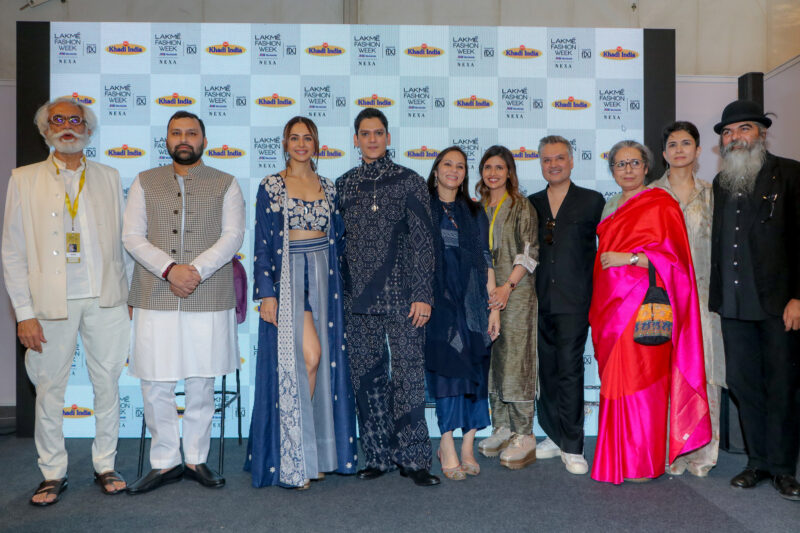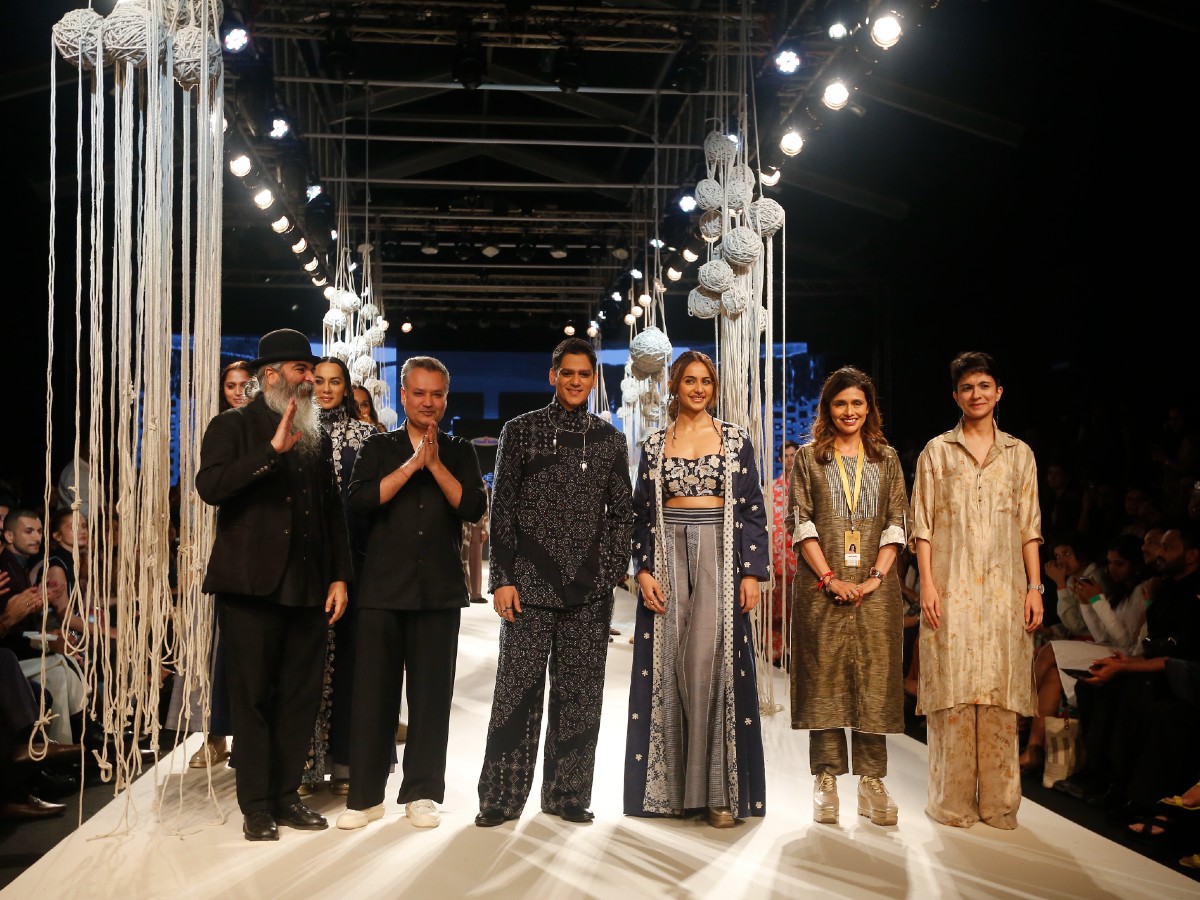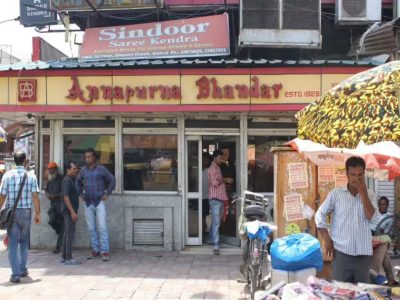Sobriety and austerity are the words usually associated with khadi, leaving the fabric restricted to an older generation.
However, Divyam Mehta, Shruti Sancheti, Suket Dhir and Co-Ek’s Nargis Zaidi joined hands with the Fashion Design Council of India (FDCI) to present a youthful image of Khadi at the Lakme Fashion Week 2023 this month.
Pichwai paintings to quirky motifs, occasion wear and a Japanese translation of this freedom fabric made the show a visual treat.
The winner of the International Woolmark Prize in 2016, Suket Dhir injected both humour and fine khadi into his line. He calls his effort ‘modernising’ and not ‘westernising’.
The black bucks are wearing bulletproof jackets, the leopard a helmet for safe driving, and hornbill is wielding a microphone in his new-age motifs.
Each of these Indian animals have been given a personality. There is fun and pun intended by Dhir who grew up in Banga, Punjab, and was heavily inspired by his grandfather’s orchards, as well as his signature bowler hats, which are a part of his persona.
The idea was to break stereotypes and the purist attitude around Khadi, and to simply shift the focus on the weave and not weaver.
If the weave gets elevated, the weaver will benefit.
This is an extension of Dhir’s sassy Maharanis riding motorcycle prints some years ago, which won him both fans and a few smiles.

In all this mundaneness, Dhir likes to make conversational pieces, where there is meta-messaging and story-telling. Thus, his Khadi denims have a bit more depth, a bit nudge-nudge and wink-wink ethos, which is appreciated by young audience.
“The translation needs to be updated and our crafts are too rich to be made mediocre. Khadi will remain relevant, it needs to be removed from the shackles of mediocrity by concentrating on quality,” he says.
In this journey of making Khadi super cool, there is also the contribution of the Fashion Design Council of India chairman, Sunil Sethi, who believes that Khadi is the purest fabric which keeps you cool in summer and warm in winter.
There is a misconception that its thickness will be a barrier in summer. In fact, it absorbs sweat and is ideal for a tropical country like India.
Khadi, in his leadership, has been adopted by various designers and Suket admits Sethi helped him source material from various clusters with ease, making sure the craft is resuscitated.
“The Khadi and Village Industries Commission (KVIC) is working tirelessly to make sure Khadi reaches every wardrobe effortlessly with ingenious design interventions,” says Sethi.
Unfortunately, despite living in a city like Delhi which can battle soaring temperatures, we still prefer to wear a suit and then blast the air conditioning, and then wax eloquent on sustainability and resource depletion.
“The change has to come from us — how we dress, work with our own ecology, seasons and climate,” says Suket.
In menswear, his denim line comes with quilted puffers filled with semal cotton, jackets as well as gentle Jamdanis with endearing prints for everyday wear.
The key to GenZ’s acceptance of Khadi comes with how he manipulates the weight, mixing it with mul-mul (muslin), so that it does not lose shape, something Khadi was often criticised for. The treatment with mul-mul makes it supple.
“Denims are long lasting, up to 15 years.They are rugged and durable, collectibles, making it young people’s favourite,” he explains.
Shruti Sancheti, who runs a successful store in New Delhi Pinnacle, believes Khadi has always been looked at only for casual wear.
She embarked on a journey to make it an integral part of festivities. She decided to convert it into a play of stripes and checks, with a neutral colour palette of indigo and beige, as well as maroons and rust.
“Mokaish is an Indian technique which has sparkle, and I thought this would be ideal, mixed with the cord embroidery, for a cool quotient,” says Shruti.
Small detailing goes a long way in deciding how we approach slow fashion.
That’s why traditional block printing has been employed, as well as hand-smocking, laborious techniques which add a dimension to conventional khadi ensembles.
“I wanted to offer the youth, our growing population, separates that they can mix and match, in multiple ways according to their individuality. It is a season fluid line, which is layered, contemporary, and exuding a global appeal. You can remove the vest and wear it with your jeans or the jacket can be worn with your already existing skirt,” she affirms.
Nargis Zaidi, who heads the apparel division of Co-Ek Centre of Excellence for Khadi, set up by KVIC- Ministry of Ministry of Micro, Small and Medium Enterprises (MSME), in association with NIFT, has given this fabric a new look by using Musheerabad fine muslin as well as weaves from Gujarat.
Co-Ek was instituted to create ensembles in khadi for the domestic and international market, without compromising on aesthetics, and was targeted towards the youth.
Co-Ek is rewriting how Khadi has been perceived, and exploring the possibilities on how it can be woven, making it trendy. Thus, they have launched menswear, womens wear as well as a wellness line different from what one bought from Khadi bhandars.
KVIC helped in sourcing the fabric from all over the country — Shillong, Bengaluru to Kolkata. It identifies clusters and their needs conducting a diagnostic study.
The saris they displayed were made with natural dyes, Bagru, indigo, with technical and design inputs. They work on building programmes for improving stitching quality, as well as loom upgradation.
“Growing up in Baroda, I saw my mom wearing cotton saris, and my earlier experience working with Fab India, Sewa Gujarat helped in understanding handlooms,” says Nargis who graduated from NIFT, Gandhinagar.
The saris are emblazoned with folk art, Pichwai and they also have Bijlee saris (black and white). Some are styled with printed petticoats to give a peek-a-boo feel.
For the international buyer, there are also woollen Khadi jackets woven in Bikaner with Daboo printing techniques, as well as Eri silk from Assam.
“The Ministry of MSME conceived the Centre of Excellence for Khadi (CoEK) to address the needs of the Khadi and Village Industries Commission (KVIC). We want to make Khadi a global brand,” she says.
Divyam Mehta’s line ‘Kacho’ or raw is infused with the patterns of Rabari wall art.
Women draw shapes and forms derived from their immediate surroundings and improvise as they proceed. It is a collage of visuals put together on an impulse.
“Our spring-summer collection is an amalgamation of rural wall paintings, dots laid out in geometrical patterns, spontaneous brush strokes and patiently embroidered Kantha stitches,” says Divyam.
The textures of Khadi cottons and denims are elevated with renders of stitches, imprints of hand carved wooden blocks and screen prints.
The coming together of scattered elements form the unique identity of this collection.
Kacho consists of a sombre and quiet palette — slate, fossil grey and indigo.
“Minimal yet stark stitches on tailored jackets, trousers, odhanis and cocoon like drapes are seen throughout the range. Simple stitches become one with the textile, further enhancing its tactile nature. This collection is a hybrid medley of draping, meticulous patterns, and artisanal construction which is complemented with rows of darning stitches to reinforce seams,” he concludes.





